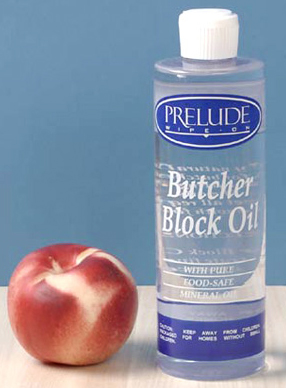
What do the experts suggest using as a finish on a butcher block countertop? I’m asking because I just read the article about how thick a butcher block should be (eZine issure 270) and then forwarded it to my son in Grand Rapids, Michigan. He was quite impressed. Thanks to your magazine and what it’s doing. I have learned to appreciate Woodworker’s Journal, the more I read it. – Doug Selfe
Chris Marshall: When I was in high school, I worked behind the meat counter at a local grocery store. The butcher block received nothing in the way of “finish” besides regular contact with meat fat. The end grain soaked up enough of that fatty oil over time to bead up when water was applied to it. Even daily cleaning with an ammonia solution didn’t stop the wood from beading water. That said, I would be inclined to finish your countertop with a butcher block or salad bowl finish or possibly just mineral oil – some nontoxic oil-based finish that would be easy to replenish when the surface begins to look dry. Maintenance would sure be simple: flood on a new coat, let it soak into the wood and wipe off all the excess. This would be a better solution than applying a film-forming topcoat like varnish that wouldn’t stand up to repeated exposure to water, heat, kitchen cleaners, knife edges, etc. Actually, no finish is going to last long on a countertop next to a busy kitchen sink, so I’d want to make refinishing as easy as possible.
Tim Inman: I’m sure this question will get a wide range of responses! My wife (who teaches culinary arts) would say, “Nothing!” She wants just a plain, clean, cleanable wood surface. I made “cutting board” countertop insets for her many years ago, and she has cut, chopped, shredded, grated, kneaded and peeled on them ever since. Indeed, they do show knife scars and badges of wear and tear, but they look “right” in a real working kitchen. Finisher that I am, I do like to at least give the wood a coat of wax or oil from time to time. (She won’t read this, so it will just be our little secret, right?)
However, plain old wood may not be everyone’s cup of tea. Any “film-building” finish you might apply will be subject to chipping, peeling and scratching. This may be fine – especially if the chef is wanting something that looks better, and is willing to treat the surface with more respect for the aesthetic, and less demand for the utilitarian.
A happy bridge might be a finishing oil like tung oil or an oil/wax/varnish blend (Sam Maloof’s favorite) that will soak into the wood surface and provide some aesthetic enhancement, but will not be so vulnerable to surface failure. Oils can be reapplied without much stress. Film building surfaces can only be repaired or refreshed with much work and preparation.
The wood will be fine, whatever your choice. The use and enjoyment of the tops will be reflected in your pick. Select the finish, if any, that will perform the function you most want.





